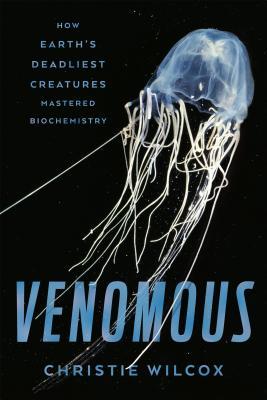 It’s amazing what tiny little creatures such as the blue-ringed octopus or a little caterpillar in the rainforest can do to you (paralyze you completely and induce hemorrhaging, respectively), without even your realization that you’ve been bitten or pricked! Where Wilcox really shines in Venomous, though, is when she goes beyond show-and-tell and explains what goes on when you graze the back of that caterpillar with its bristly spine: contrary to what might be expected, this little caterpillar actually causes all the coagulants in your blood to become otherwise engaged so that they’re nowhere to be found while the rest of your blood is running rampant. Hence the hemorrhaging.
It’s amazing what tiny little creatures such as the blue-ringed octopus or a little caterpillar in the rainforest can do to you (paralyze you completely and induce hemorrhaging, respectively), without even your realization that you’ve been bitten or pricked! Where Wilcox really shines in Venomous, though, is when she goes beyond show-and-tell and explains what goes on when you graze the back of that caterpillar with its bristly spine: contrary to what might be expected, this little caterpillar actually causes all the coagulants in your blood to become otherwise engaged so that they’re nowhere to be found while the rest of your blood is running rampant. Hence the hemorrhaging.
Venomous is engaging and serves as a great introduction into the world of venom and the creatures that produce them. Wilcox takes you through a variety of different types of venom, organized more or less by chapter, telling you what they do to their (unfortunate/maybe-brought-it-upon-themselves) victims, connecting their incredible abilities to theories as to why certain creatures should have developed the venoms that they did. In fact, Wilcox goes further and delves – relatively lightly, nothing to be afraid of even if you’re not scientifically minded – into the science of what different venoms do. What you get, in effect, is something along the lines of this: what creature generates what sort of venom, which does what to which animal by targeting which areas, likely influenced by which evolutionary pressures. Wilcox breaks it down so that you understand what’s going on – which neurotransmitters are involved? what areas of the body does it affect and why? why might these creatures have evolved as they did? – as you make your way through the rest of the book, keeping all the information intact by making connections throughout.
What’s really fun is seeing other authors I’ve read pop up as references in other books I’m reading, also! Wilcox makes reference to Isbell’s theory, found in The Fruit, The Tree, and the Serpent, concerning snakes and the part they may have played in our evolution, with a focus on our vision. (Granted, I didn’t actually finish The Fruit, The Tree, and the Serpent, though it’s back on my to-read list, but it’s still pretty cool when that happens.) So back to Venomous. Wilcox goes into just enough detail – enough to get you to understand, plus a bit more now that you know what’s going on – every time she talks about a specific creature (e.g. the platypus, box jellyfish, stingray, etc.), complete with engaging anecdotes both personal and from others who have experienced these creatures’ mastery over biochemistry, as well as what uses these creatures may have for us once we can harness their potential, so that what you end up with is an easy introduction to venoms and the creatures that produce them that is also accessible enough for someone who may not be well versed in chemistry (hello!).
Further Reading
The Fruit, The Tree, and the Serpent by Lynne Isbell
Octopus! by Katherine Courage
A search on our catalogue on poisonous animals (which are different from venomous creatures, as you will discover upon reading Venomous)